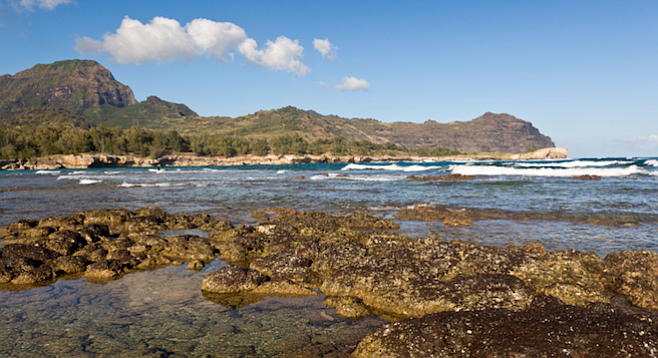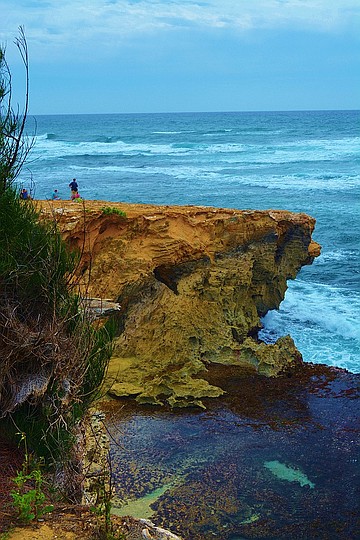 Facebook
Facebook
 X
X
 Instagram
Instagram
 TikTok
TikTok
 Youtube
Youtube

Known for its unique geography and natural wonders, Kauai is one of the most breathtakingly beautiful places I've visited. A hiker’s dream. Truth be told, even if you're not an avid hiker, the island's outdoors just call out to be explored.
Our hearts were set on introducing our fellow travelers to the spectacular Na Pali Coast, renowned for rugged grandeur, secluded beaches, rainbow waterfalls, and yes, challenging, daunting hikes. Three days of heavy rains and flooding foiled our plans. Steep, treacherous cliffs and slick trails make for heart-failing excitement – just not the kind of excitement we were looking for. Even under the best conditions the Na Pali Coast can be dangerous, with its washed-out trails and narrow, stony paths clinging precariously to the edge of cliffs.
With more rain expected in the forecast, we reluctantly took locals' advice and headed south to the sunny shores of Poipu. It is here on the south side of Kauai that we found unexpected treasure.
Kauai’s southern coastline features a fascinating path along the ancient, fragile ecosystem of the Maha’ulepu Heritage Trail. The trail begins on crescent-shaped Shipwrecks Beach near the Grand Hyatt in Keoneloa Bay. A fishing vessel was said to have run aground on the bay’s sandbar. Though remains of the vessel are now “lost at sea,” the beach retains its famous name.
Leaving the tropical white sandy beach, we were surprised to find ourselves in groves of fresh, fragrant pine trees. Our path covered with thousands of soft green needles. Colorful flora and fauna of the forest surrounded us. With few hikers to be seen, we felt as if the trail was ours alone.

After a gentle upgrade, we emerged into a completely different world. Framed by azure skies and miles of deep blue sea, the stunning coastline lay before us. Views of the churning ocean were visible from vantage points over sun-bleached cliffs. Blowholes shooting occasional sprays of salty ocean water along the path demonstrated the sea's power here at high tide. Binoculars in hand, we ventured closer, our excitement piquing with the unexpected sight of massive humpback whales breaching in the distance.
The Makawehi Lithified Cliffs loomed ahead, appearing like an alien landscape. These cliffs were formed from sand dunes weathered by wind and surf over thousands of years. Crashing wave action carved sharp ridges and deep pockets in the cliffside; lithification occurred when sediments compacted, then filled pores with ground water containing high levels of minerals. All in all, a fascinating scientific explanation that translates to spectacular views.
Each bend in the path yielded more surprise, the element of any good journey. Crystal-clear tidepools teemed with tiny fish and miniature crabs, all scurrying to find safety as each wave brought more water surging in. Fossils and petroglyphs carved into the rocks lined the coastal pathways. (Paleontologists have discovered the skeletal remains of extinct birds that lived here over 1,500 years ago, before Polynesian voyagers first arrived.)
Each outcropping of rock, each sheltered bay and inlet, each changing vista yielded more panoramas and more geological wonders. Nearby cave entrances begged to be explored, while the thundering surf below warned us of the might of the Pacific.
On our return trip, we followed the interior trail away from the direct sun and into the welcoming shade of the palm and coconut forest. Since the paths split and merged repeatedly, we were able to easily navigate a completely different route back.
Much to our surprise, we stumbled across an ancient Hawaiian burial site. The stillness was interrupted only by a gentle breeze stirring through the treetops, reminding us that for the old gods, their mana still lives here. Eyes closed, we sensed the spirit of the ancient Hawaiians in this sacred ground.
Returning to Shipwrecks Beach, we were certain we could undertake this adventure multiple times and it would never be the same. As Louis L’Amour once said, “The trail is the thing, not the end of the trail. Travel too fast and you miss all you are traveling for.” We are thankful to have experienced this unexpected treasure.
And about that initial disappointment in forgoing the Na Pali trail: nature’s artistry took care of that.
Take Highway 50 east from Hanapepe. Turn right on Highway 520 toward Po'ipu. At the end of 520, turn right on Koloa Road and then left on Poipu Road.
Park in the lot near the Hyatt Hotel and take the trail between this hotel and the Poipu Bay Resort golf course. OR, go to the east end of Shipwreck Beach to access the cliff trails. The hike is a round trip of approximately 3 ½ miles. Plan on at least two hours; more if you love to explore.


Known for its unique geography and natural wonders, Kauai is one of the most breathtakingly beautiful places I've visited. A hiker’s dream. Truth be told, even if you're not an avid hiker, the island's outdoors just call out to be explored.
Our hearts were set on introducing our fellow travelers to the spectacular Na Pali Coast, renowned for rugged grandeur, secluded beaches, rainbow waterfalls, and yes, challenging, daunting hikes. Three days of heavy rains and flooding foiled our plans. Steep, treacherous cliffs and slick trails make for heart-failing excitement – just not the kind of excitement we were looking for. Even under the best conditions the Na Pali Coast can be dangerous, with its washed-out trails and narrow, stony paths clinging precariously to the edge of cliffs.
With more rain expected in the forecast, we reluctantly took locals' advice and headed south to the sunny shores of Poipu. It is here on the south side of Kauai that we found unexpected treasure.
Kauai’s southern coastline features a fascinating path along the ancient, fragile ecosystem of the Maha’ulepu Heritage Trail. The trail begins on crescent-shaped Shipwrecks Beach near the Grand Hyatt in Keoneloa Bay. A fishing vessel was said to have run aground on the bay’s sandbar. Though remains of the vessel are now “lost at sea,” the beach retains its famous name.
Leaving the tropical white sandy beach, we were surprised to find ourselves in groves of fresh, fragrant pine trees. Our path covered with thousands of soft green needles. Colorful flora and fauna of the forest surrounded us. With few hikers to be seen, we felt as if the trail was ours alone.

After a gentle upgrade, we emerged into a completely different world. Framed by azure skies and miles of deep blue sea, the stunning coastline lay before us. Views of the churning ocean were visible from vantage points over sun-bleached cliffs. Blowholes shooting occasional sprays of salty ocean water along the path demonstrated the sea's power here at high tide. Binoculars in hand, we ventured closer, our excitement piquing with the unexpected sight of massive humpback whales breaching in the distance.
The Makawehi Lithified Cliffs loomed ahead, appearing like an alien landscape. These cliffs were formed from sand dunes weathered by wind and surf over thousands of years. Crashing wave action carved sharp ridges and deep pockets in the cliffside; lithification occurred when sediments compacted, then filled pores with ground water containing high levels of minerals. All in all, a fascinating scientific explanation that translates to spectacular views.
Each bend in the path yielded more surprise, the element of any good journey. Crystal-clear tidepools teemed with tiny fish and miniature crabs, all scurrying to find safety as each wave brought more water surging in. Fossils and petroglyphs carved into the rocks lined the coastal pathways. (Paleontologists have discovered the skeletal remains of extinct birds that lived here over 1,500 years ago, before Polynesian voyagers first arrived.)
Each outcropping of rock, each sheltered bay and inlet, each changing vista yielded more panoramas and more geological wonders. Nearby cave entrances begged to be explored, while the thundering surf below warned us of the might of the Pacific.
On our return trip, we followed the interior trail away from the direct sun and into the welcoming shade of the palm and coconut forest. Since the paths split and merged repeatedly, we were able to easily navigate a completely different route back.
Much to our surprise, we stumbled across an ancient Hawaiian burial site. The stillness was interrupted only by a gentle breeze stirring through the treetops, reminding us that for the old gods, their mana still lives here. Eyes closed, we sensed the spirit of the ancient Hawaiians in this sacred ground.
Returning to Shipwrecks Beach, we were certain we could undertake this adventure multiple times and it would never be the same. As Louis L’Amour once said, “The trail is the thing, not the end of the trail. Travel too fast and you miss all you are traveling for.” We are thankful to have experienced this unexpected treasure.
And about that initial disappointment in forgoing the Na Pali trail: nature’s artistry took care of that.
Take Highway 50 east from Hanapepe. Turn right on Highway 520 toward Po'ipu. At the end of 520, turn right on Koloa Road and then left on Poipu Road.
Park in the lot near the Hyatt Hotel and take the trail between this hotel and the Poipu Bay Resort golf course. OR, go to the east end of Shipwreck Beach to access the cliff trails. The hike is a round trip of approximately 3 ½ miles. Plan on at least two hours; more if you love to explore.
Comments